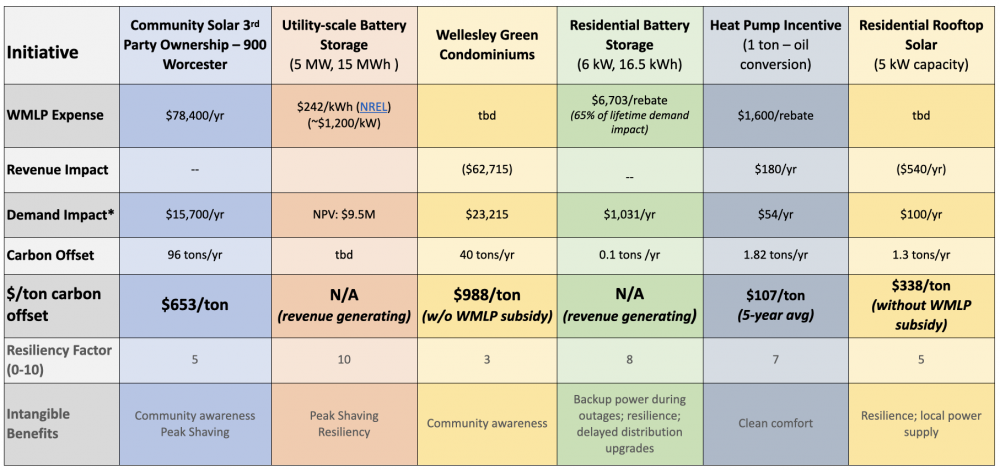How Wellesley’s Municipal Light Plant is spending those WECARE funds
Wellesley’s Municipal Light Plant introduced an opt-out program called WECARE in 2021 that tacked 4% onto customers’ bills to subsidize and fund local projects focused on greenhouse gas emissions reduction. The program, whose acronym is spelled out as Wellesley Electric Customers Accelerated Reduction of Emissions, was the subject of debate at Town Meeting in 2020, with some finding the opt-out process distasteful and others citing the benefits of the MLP investing for the future.
We’ve had questions from readers of late wondering what has become of the funds raised through WECARE, a program that will be 2 years old mid-year and that currently has about a 9% opt-out rate among customers. The MLP answered some of those questions in its annual presentation to the town’s Advisory Committee on Jan. 5 (see Wellesley Media recording) and clarified others based on our follow-up questions.
In an email from MLP Director Don Newell, he shared that total annual funds collected under WECARE are about $880,000. The MLP is setting aside 15% to purchase Class 1 Renewable Energy Credits and another 15% to support the community solar project installed last spring atop the building at 900 Worcester St. (Boston Sports Institute). Some $18K has also gone into a residential decarbonization audit program to help homeowners chart a path to eliminate use of fossil fuels.
The remaining funds haven’t been designed for a specific use, but the MLP has plenty of options under consideration that sync up with the town’s broader Climate Action Plan. These include:
- Incentives for customers to convert to heat pumps for heating and cooling
- A project to demonstrate residential battery storage
- Technical training and materials for Wellesley’s new volunteer Energy Coach initiative
- Demand management and cost reduction program for large commercial customers
During his presentation to Advisory, MLP Board Chair Paul Criswell described WECARE as “one of the centerpieces of our efforts to move forward towards sustainability.” He described WECARE as supporting efforts that might not be “justifiable on purely economic grounds,” and outlined them in a chart we’ve embedded below.
One of the more ambitious efforts to date has been working with the operator of 900 Worcester St., to lease the rooftop to support solar panels installed by a third-party firm. The MLP then agreed to purchase all of the energy produced there at a premium to resell to its customers. “But by the same token, we believe we are saving the world about 96 tons of carbon a year that would otherwise go into the air…” he said.
WECARE is also supporting the MLP’s push for heat pump adoption. It has offered rebates to homeowners converting to energy-efficient heat pumps, and is considering a project to pump up the Wellesley Green condo complex with these devices.
You’ll be hearing a lot more about battery storage, too, from the MLP, and WECARE funds will be behind some of this. The MLP is looking at bringing battery storage devices to residences for backup power, as a possible complement to rooftop solar. But its big plan is for a Battery Energy Storage System project dubbed BESS (a 4.99 MW/15 MWH battery system) with Citizens Energy. The plan is for it to be installed on property at Municipal Way alongside MLP headquarters most likely in late summer or early fall of this year with completion likely in June of 2024, according to Francisco Frias, assistant director at the MLP. Article 31 at Annual Town Meeting will address some tax aspects of this project.
There will be no upfront costs for Wellesley, as Citizens Energy will install the large-scale batteries and operate them for 20 years under the contract. So while WECARE funds may be needed to support this in some way, it’s unclear at this point what those costs might be. The batteries will be charged from the WLP energy system and then that energy can be used during peak demand periods (for “peak shaving”), or possibly to provide emergency power to the police and fire departments if something were to happen to the main MLP energy system. The savings from using this battery system would be divvied up between Citizens and the MLP, with the MLP saving an estimated $8M over 20 years.
In addition to the potential for reducing carbon emissions, such projects would also contribute to Wellesley’s ability to gain more control over its energy use in general. This could help the town use less energy during peak demand times, when energy is most expensive, and that could help Wellesley save money. As we’ve seen energy costs rise this year due to various outside influences, having more control will only become more desirable.

